Helsinki commuter rail
Helsinki commuter rail (Finnish: Pääkaupunkiseudun lähiliikenne, Swedish: Huvudstadsregionens närtrafik, literal translation Local traffic of the capital region) is the commuter rail system serving Greater Helsinki, Finland. The network is part of the HSL network, and is operated by VR, the Finnish state-owned national railway company. Together with the Helsinki Metro, buses, and trams, the network forms the heart of Helsinki's public transportation infrastructure.
 | |
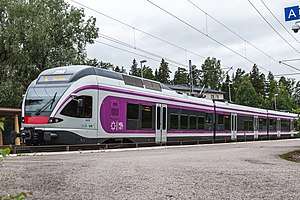 | |
| Overview | |
|---|---|
| Area served | Uusimaa, Päijänne Tavastia, Tavastia Proper, Pirkanmaa |
| Locale | Greater Helsinki |
| Transit type | Commuter rail |
| Number of lines | 14 |
| Number of stations | 44 in the HSL region 70 in total [1][2] |
| Daily ridership | 200,000 daily (2018)[3] |
| Annual ridership | 70 million (2018)[4] |
| Website | https://www.hsl.fi/en https://www.vr.fi/cs/vr/en/frontpage |
| Operation | |
| Began operation | 1886 (original) 1969 (current form) |
| Operator(s) | VR on behalf of HSL |
| Technical | |
| System length | 235 km (146 mi) (total length) 99.2 km (62 mi) (dedicated "city rail" tracks located entirely within the HSL zone) |
| Track gauge | 1,524 mm (60.0 in) |
| Electrification | 25 kV / 50 Hz |
| Average speed | 54 km/h (34 mph) |
| Top speed | 120 to 160 km/h |
Trains run primarily above ground in the Helsinki metropolitan area. Within the municipalities of Espoo, Helsinki, Kauniainen, Kerava, Kirkkonummi, Siuntio, Vantaa and Tuusula, the system uses tickets that are interchangeable with the bus, metro, and tram networks managed by HSL. The HSL area is divided into four zones (A-D).[5] Travelling beyond the HSL area, one must use VR commuter tickets. Passengers travelling from the HSL area to stations located within Järvenpää (Ainola, Järvenpää, Saunakallio, Haarajoki) and vice versa can use both VR and HSL commuter tickets, despite Järvenpää not being within the HSL area. This is due to its being situated between the Kerava and Jokela stations, both of which belong in the HSL area.
The network is composed of 14 separate services, pictured in the network map below. They operate on four branches of railway lines that all begin, and terminate, at the Helsinki Central Station. The system has a total of 70 stations, 14 of which are located within the city of Helsinki. There are about 676 departures every weekday.[6] The commuter rail services carried a total 70 million passengers in 2018.[4]
Tickets used to be sold aboard all the commuter trains by conductors until June 2017. Afterwards conductors have been repurposed to inspect tickets, assist passengers and do light maintenance tasks. Nowadays the tickets must be purchased beforehand, from ticket-vending machines, kiosks or via mobile.
In September 2018, HSL prequalified seven parties that had expressed interest in operating the services from June 2021 until 2031, namely VR, Arriva, FirstGroup, Go-Ahead Group, MTR Nordic, SJ and Transdev.[7] On 5 May 2020, HSL announced that VR has been selected to continue to operate the Helsinki commuter rail in said upcoming contract, citing higher than expected cost savings in VR's proposal.[8]
History
In the Helsinki region, local train services have existed since 1886, when four daily commuter services using steam locomotives were offered on the Helsinki–Riihimäki railway up to Järvenpää railway station in Järvenpää.
Rantarata
The Rantarata ("coastal line") was completed in 1903. This line was built mostly with commuter traffic in mind. The construction of housing began near the stations.
Steam locomotive era
During the steam locomotive era, local traffic was handled with locomotives like the Pr1 and wooden carriages with wide doors for embarkment. The number of trips increased vastly after Finland gained independence in 1917, with 4 million trips made in 1920 and 9 million in 1924. The depression of the 1930s decreased the number of commuters; at its lowest, there were only 3 million trips per year. By 1939, the amount of trips had risen back to 4 million.[9]
Diesel locomotive era
During the short diesel locomotive era from the end of the 1950s to the beginning of the 1970s, commuter services used DMUs of classes Dm7, Dm8, and Dm9.
Electrification
The tracks were not upgraded during either the steam or diesel eras. Both Päärata and the beginning of Rantarata west to Kirkkonummi were the only sections of track to accommodate long-distance, freight, and commuter trains. Parts of Rantarata are still single-tracked between Kirkkonummi and Turku.
Operation similar to the system's current state started in 1969 when the first stretch, between Helsinki and Kirkkonummi, was electrified. Route designation letters were introduced on 28 May 1972. In the same year, the then-existing commuter routes were completely electrified and a third track was added between Helsinki and Tikkurila. The third track was extended up to Kerava in 1981.
Martinlaakso extension
The railway branch from Huopalahti to Martinlaakso, opened in 1975, was built exclusively for commuter trains, being the first of its kind in Finland. It was later further extended to Vantaankoski in 1991. In 2015, it was connected to Hiekkaharju railway station, on Päärata, by the Ring Rail Line.
Currently, on the track sections between both Helsinki and Leppävaara and Helsinki and Kerava, the commuter services use rails parallel to, but separate from those used by long-distance trains, following the German-style S-Bahn principle. The fourth track, which enabled separate city track traffic, was ready up to Tikkurila in 1996 and extended to Kerava in 2004. On the Rantarata, the section between Pasila and Leppävaara was upgraded directly from dual track to four tracks in 2001.
Z service to Lahti
The railway branch from Kerava to Lahti, opened in 2006, was built as a shortcut for long-distance services, and also for the use of the new commuter service line Z.
Ring Rail Line
Service on the Ring Rail Line, connecting Helsinki Airport to the existing railway network at Vantaankoski and Tikkurila, started on 1 July 2015. The station at the airport was opened later, with the Tietotie entrance opening on 10 July and the direct connection to the terminal opening later in the fall. The newly built line extended the Vantaankoski branch via Aviapolis and Helsinki Airport to the Päärata just north of Tikkurila station. The extension introduced five new stations with reservations for three more. Unlike other tracks, a section of the Ring Rail Line beneath the airport runs underground with tunnel stations serving both the airport and Aviapolis. It is possible to construct a branch line to Klaukkala in the future.
Future extensions
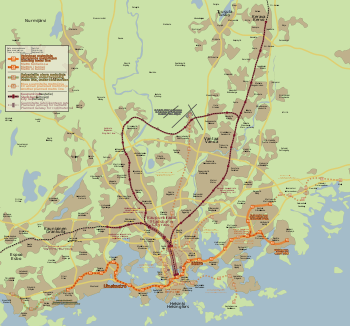
There are plans to extend the four track line from Leppävaara to Espoo. This would enable a shorter headway service to Kauklahti and also benefit long-distance traffic to Turku, which is now hampered by commuter trains on the same tracks on the section between Kirkkonummi and Leppävaara.
A major increase in capacity of the Helsinki Central railway station has been planned, as rail capacity at Helsinki station is fully used at peak hours, preventing increases in service. The City Rail Loop would feature an underground, drop-shaped section of rail beginning south of Pasila station and coming back after traveling in a loop around under the city centre. There would be three underground stations: Töölö (west), Helsinki city centre (south), and Hakaniemi metro station (east). The Rail Loop will be 7 kilometres (4 mi) long.[10] The extension is estimated to cost about €956 million and is planned to be completed in the 2020s. The Kerava–Porvoo rail line (fi; sv), which is still operated from Kerava to Kilpilahti oil refinery as a freight line and from Olli to Porvoo as a museum railway (fi:Porvoon museorautatie), is currently not in use for passenger traffic, however there are proposals to reinstate commuter traffic up to Nikkilä using this line.[11] A branch from Petas on the Ring Rail Line to Klaukkala is also proposed.[12] In the longer term, once the ELSA-rata high speed rail line from Espoo to Salo is completed, commuter services will operate to Lohja.
Routes
Rantarata (The Coastal/Turku Line)
The Y line is the longest line on the Coastal Line. It operates between Helsinki and Siuntio with very few intermediate stops. The services run quite infrequently, with seven daily departures in each direction on weekdays and with no departures on weekend. The train has scheduled stops at Pasila, Huopalahti, Leppävaara, Espoo, Kauklahti, Masala and Kirkkonummi. One Y-line service is operated from Karis to Helsinki, departing Karis on early morning. When Finland's first electrified line (from Helsinki to Kirkkonummi) was opened, the first service was Y. In 1987 the former Y train service ended and was replaced by S and U trains in 1988. In 2002, the route designation Y was introduced again, as after the Leppävaara city tracks were finished, there was a possibility to add a fast commuter train connection to Karis. Before this, a few of the S and U services continued from Kirkkonummi to Karis. In March 2016 the Y line was shortened to Siuntio. In August 2019, the Y train started stopping at Kauklahti station.[13] This change was made due to increased passenger amounts on the coastal line and in order to equalize the passenger amounts on both the Y train and the slower U train.
Train U runs from Helsinki to Kirkkonummi. The line operates with 30 minutes intervals and stops at Pasila, Huopalahti, Leppävaara, Kilo, Kera, Kauniainen, Koivuhovi, Tuomarila, Espoo, Kauklahti, Masala, Jorvas and Tolsa. The line was originally introduced in 1988, but had only few departures during peak hours back then and stopped at fewer stations then nowadays. In March 2016 two small stations between Kauklahti and Masala were closed and U train began to operate every 30 minutes, replacing the S-line.
Train L runs from Helsinki to Kirkkonummi. The service runs only at nights and on weekend mornings, stopping at all stations. One late L train service operates from Helsinki up to Karis, making a stop also at Siuntio. The L train was originally the basic train on the route Helsinki-Kirkkonummi operating primarily with 1 hour intervals. When Leppävaara city tracks were opened for traffic in 2002, the L train became a low traffic train.
Train E runs from Helsinki to Kauklahti. The train stops at Pasila, Huopalahti, Leppävaara, Kilo, Kera, Kauniainen, Koivuhovi, Tuomarila and Espoo. The line operates with 30 minute intervals. The E train was originally introduced in 1974 as an additional line to the L train and used to stop at all stations until 2002, when Leppävaara city tracks were opened for traffic. The route was continued in August 2007 to Kauklahti from the former terminus at Espoo station. If city tracks extension from Leppävaara to Espoo station is constructed, E train will form backbone of commuter traffic on the Coastal Line, calling at every station between Helsinki and Kauklahti and replacing the current A train.
Train A runs from Helsinki to Leppävaara, stopping at all station. The train operates with 10-minute intervals during rush hours, otherwise at 20-minute intervals on working days and at 30-minute intervals on weekends. The route designation A was originally used from 28 May 1972 to 25 May 1974 for Kirkkonummi service, and it was re-introduced in June 2002.
The Ring Rail Line and Vantaankoski Line
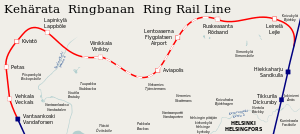
Trains I and P run in opposing directions to each other in a ring pattern between Helsinki and Helsinki Airport in Vantaa. They stop at all stations. The I train runs counterclockwise, leaving from Helsinki, then passing through Tikkurila, then through Helsinki Airport, and through Martinlaakso back to Helsinki. The P train does this clockwise (in reverse), leaving from Helsinki, then passing through Martinlaakso, then through Helsinki Airport, and through Tikkurila back to Helsinki.
The Ring Rail line was completed in 2015, and acted as a continuation of the Vantaankoski Line, simultaneously replacing the M train with P, and extending the I train past its original stop at Tikkurila.
The Main/Riihimäki Line
Train K runs from Helsinki to Kerava, stopping at all stations. During 1970's and 1980's the train did not stop at any station between Pasila and Tikkurila. Malmi was added to the stopping pattern in 1988 and Puistola was added in 1996. Oulunkylä was added only after completion of city tracks to Kerava in 2004. In August 2019, the K train started to stop at all stations between Helsinki and Kerava, replacing the N train entirely.[13] This change was made in order to make the stopping pattern of commuter trains on Kerava city tracks clearer by having the trains (I, P, K, T) stopping all stations. The change should also make the operation of commuter trains easier during traffic disruptions. An extension of the line to Nikkilä in Sipoo has been planned using a part of existing branch to Kilpilahti oil refinery.
Train T runs at night once in an hour from Helsinki to Riihimäki, stopping at all stations. The line has three services during weekdays and eight during weekends.
Train R runs from Helsinki to Riihimäki. The trains stop between Helsinki and Riihimäki at Pasila, Tikkurila, Kerava, Ainola, Järvenpää, Saunakallio, Jokela and Hyvinkää and operates primarily with 30 minute intervals. All R trains have low floor fleet and timetable requires trains to be capable of 160 km/h speed. R is an original letter from 1972 and has been running on same stop scheme since the inception with one exception which was adding Tikkurila stop in the 80s and both Ainola and Saunakallio in March 2016. The R train also increased the service frequency when the H train was discontinued. Some of the R trains continue from Riihimäki further to Tampere, stopping at Ryttylä, Turenki, Hämeenlinna, Parola, Iittala, Toijala, Viiala and Lempäälä. These trains are operated with a more irregular interval. On weekends, one commuter train service on R-line, departing Helsinki at 0:40 a.m. is operated all up to Hämeenlinna.[14]
Train D runs from Helsinki to Riihimäki. The train stops at Pasila, Tikkurila, Kerava, Järvenpää and Hyvinkää and is operated only on weekdays during peak hour, with three morning departures from Riihimäki and two afternoon departures from Helsinki. The D train departing Helsinki at 15:50 is operated up to Hämeenlinna, making a stop also at Ryttylä and Turenki. The first D train service towards Helsinki in the morning is operated all up from Hämeenlinna.[14] The trains are operated with three to four Sm2 class train units, the D train operated to Hämeenlinna however is operated with Sm4 class train units. The D train was introduced in March 2016, replacing the former peak hour services that did not use any letter. The trains were originally operated with Eil/Eilf class commuter coaches pulled by a locomotive. The original stops were at Pasila, Tikkurila, Järvenpää and Hyvinkää. In August 2016, the stop at Tikkurila was abolished and replaced by a stop at Kerava. Tikkurila was re-added to the stopping pattern in June 2017, when the D train was started to be operated with Sm2 class train units, replacing the commuter coaches.
The Lahti Line
Train Z runs from Helsinki to Lahti via the Kerava-Lahti railway line, with one hour intervals. The train stops at Pasila, Tikkurila, Kerava, Haarajoki, Mäntsälä and Henna. All Z trains have low floors and timetable requires trains to be capable of 160 km/h speed. The Z trains are often crowded during peak hours, especially between Helsinki and Kerava and are therefore operated with longer trains. Two Z trains departure from Kouvola in the morning and return there in the evening rush hour. These trains are driven with Sm2 class train units.
The Riihimäki−Lahti Line
Train G runs from Riihimäki to Lahti, being the only lettered service not terminating in Helsinki. The train stops at Hikiä, Oitti, Mommila, Lappila, Järvelä and Herrala and is operated with one hour intervals. The letter G was reintroduced on this route in 2017, replacing earlier services that didn't use any letter.
Former services
Train P ran from Helsinki to Hiekkaharju, stopping at all stations. The service was started in 1972 and stopped in August 2004. The letter P was reintroduced in 2015 as a clockwise Ring Rail train.
Train G ran from Helsinki to Saunakallio. The line had six services a day in both directions and it was the only train with letter designation on the Helsinki–Riihimäki route that did not stop at Tikkurila. The service was started on 4 June 2007. It was abolished in 2011 in order to improve management of traffic and timetable keeping on the Main Line especially during winter conditions. It used to stop at Helsinki, Pasila, Kyrölä, Järvenpää and Saunakallio. The letter G was reintroduced in 2017 on previously unlettered trains between Riihimäki and Lahti.
Train M ran from Helsinki to Vantaankoski. The train operated with 10–30 minutes intervals, stopping at all stations. The service ran continuously between 1975, when the track to Martinlaakso was completed, and 2015, when the Vantaankoski Line was continued by the Ring Rail Line. In 1991, the line was continued one stop further to Vantaankoski. The letter M stood for Martinlaakso, though the M train was substituted in 2015 with the P train, to avoid confusion with the Helsinki Metro.
Train S ran from Helsinki to Kirkkonummi. The train was operated with one hour intervals in both directions. Of the two daytime trains running between Helsinki and Kirkkonummi, the S trains were faster. The train stopped at Pasila, Huopalahti, Leppävaara, Kilo, Kera, Kauniainen, Koivuhovi, Tuomarila, Espoo, Kauklahti and Masala. From 28 May 1972 to 25 May 1974, the S trains were running between Helsinki and Kauniainen. The route was continued to Kirkkonummi on 27 September 1987. The S train was abolished in March 2016 when two small stops located between Kauklahti and Masala and served only by the U-line were closed and the U line now runs twice an hour.
Train X ran from Helsinki to Kirkkonummi. The train stopped at Pasila, Huopalahti, Leppävaara, Espoo and Masala and was the fastest commuter train service on Helsinki-Kirkkonummi line along with Y train. The X train had only one service in both directions on weekdays. The X train was introduced in March 2016 and abolished in June 2018.
Train H ran from Helsinki to Riihimäki, operating with one hour intervals. The train stopped at Pasila, Tikkurila, Kerava, Ainola, Järvenpää, Saunakallio, Purola, Nuppulinna, Jokela and Hyvinkää. The letter H is an original designation from 1972. Before 1990–98 H train had stops at Monni, Palopuro, Takoja, Huikko, Ristinummi and Kytömaa. These stops were abolished due to low passenger numbers and H train was disturbing other traffic by being too slow. Stops were discontinued and structures completely dismantled between 1990–98. In March 2016 the Purola and Nuppulinna stations were closed and the H trains were replaced with the R train that now has two additional stops and double the frequency.
Train N ran from Helsinki to Kerava, stopping at all stations. On its final years in operation, the train operated only on early morning and on evening during weekdays, with 30 minute intervals. On weekends the train operated more frequently with 10 minute intervals on Saturday and 15 minute intervals on Sunday. The N train was abolished in August 2019 and was replaced by K train, which started to stop at all stations.[13]
Lengths of the lines
- Helsinki–Riihimäki 71 km (44 mi) (54 min)
- Helsinki-Tampere 187 km (116 mi) (2h 8 min)
- Helsinki–Lahti 104 km (65 mi) (61 min)
- Helsinki–Kerava 29 km (18 mi) (23 min)
- Helsinki–Siuntio 51 km (32 mi) (41 min)
- Helsinki–Kirkkonummi 38 km (24 mi) (30 min)
- Helsinki–Kauklahti 24 km (15 mi) (29 min)
- Helsinki–Leppävaara 11 km (7 mi) (12 min)
- Helsinki-Airport via Huopalahti 26 km (16 mi) (32 min)
- Helsinki-Airport via Tikkurila 23 km (14 mi) (27 min)
Schematic of the lines[15]
| R | ||||||||||||||||||||||||||
|---|---|---|---|---|---|---|---|---|---|---|---|---|---|---|---|---|---|---|---|---|---|---|---|---|---|---|
| Tampere | ||||||||||||||||||||||||||
| Lempäälä | G | Z | ||||||||||||||||||||||||
| Viiala | Lahti | |||||||||||||||||||||||||
| Toijala | Herrala | |||||||||||||||||||||||||
| Iittala | Järvelä | |||||||||||||||||||||||||
| Parola | Lappila | Henna | ||||||||||||||||||||||||
| Hämeenlinna | Mommila | |||||||||||||||||||||||||
| Turenki | Oitti | |||||||||||||||||||||||||
| T | D | Ryttylä | Hikiä | Mäntsälä | ||||||||||||||||||||||
| Y | Riihimäki | |||||||||||||||||||||||||
| Siuntio | U | L | Hyvinkää | G | ||||||||||||||||||||||
| Kirkkonummi | Jokela | Haarajoki | ||||||||||||||||||||||||
| Tolsa | Saunakallio | |||||||||||||||||||||||||
| Jorvas | Martinlaakso | Vantaankoski | Järvenpää | |||||||||||||||||||||||
| Masala | E | Louhela | Vehkala | K | N | Ainola | ||||||||||||||||||||
| Kauklahti | Myyrmäki | Kivistö | Kerava | |||||||||||||||||||||||
| Espoo | Malminkartano | Aviapolis | Savio | |||||||||||||||||||||||
| Tuomarila | Kannelmäki | Lentoasema | Korso | |||||||||||||||||||||||
| Koivuhovi | Pohjois-Haaga | Leinelä | Rekola | |||||||||||||||||||||||
| Kauniainen | Koivukylä | |||||||||||||||||||||||||
| Kera | Hiekkaharju | |||||||||||||||||||||||||
| Kilo | A | Tikkurila | ||||||||||||||||||||||||
| Leppävaara | Puistola | |||||||||||||||||||||||||
| Mäkkylä | Tapanila | |||||||||||||||||||||||||
| Pitäjänmäki | Malmi | |||||||||||||||||||||||||
| Valimo | Pukinmäki | |||||||||||||||||||||||||
| Huopalahti | Oulunkylä | |||||||||||||||||||||||||
| Ilmala | Käpylä | |||||||||||||||||||||||||
| Pasila | Pasila | |||||||||||||||||||||||||
| Helsinki | Helsinki | |||||||||||||||||||||||||
| Y | U | L | E | A | P | I | I | P | K | N | T | D | R | Z | ||||||||||||
Rolling stock
Starting in July 2017, all commuter train services within the HSL zone will be operated by Sm5 FLIRT trains. The outgoing Sm2- and Sm4-trains will be repurposed for longer-distance lines by VR.[16]
Currently used units:
- Sm2, 50 units delivered in 1975–81 (Valmet/Strömberg)
- Sm4, 30 units delivered in 1998–2005 (Fiat Ferroviaria/CAF/Alstom)
- Sm5, 41 units delivered in 2008–17 (Stadler, model FLIRT). These trains are run by VR but owned by Pääkaupunkiseudun Junakalusto Oy. The first Sm5 unit started commercial operations in November 2009. A total of 81 units are ordered and the series will replace aging Sm1 and Sm2 units.[16]
Formerly used units:
- Sm1, 50 units delivered in 1968–73 (Valmet/Strömberg), now phased out by Sm5 fleet. Removed from regular traffic in 2016.
- Eil/Eilf commuter traffic cars pulled by a locomotive, 57 cars delivered in 1982–87 (so-called "red cars"). Removed from regular traffic in June 2017
Commuter traffic was the last commercial traffic with wooden-bodied cars on Finnish railways. They were retired in the late 1980s when the Eil cars replaced them.
- Sm5 EMU at Riihimäki on a test run in February 2009 prior to entering commercial service.
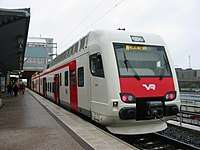 Sm4 EMU at Pasila
Sm4 EMU at Pasila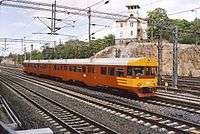 Sm2 EMU from the 1970s between Pasila and Helsinki in old colors (June 2001)
Sm2 EMU from the 1970s between Pasila and Helsinki in old colors (June 2001)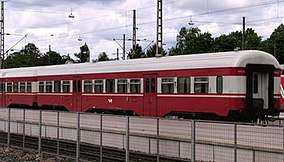 Eil class commuter cars at Helsinki Central railway station
Eil class commuter cars at Helsinki Central railway station
References
- https://www.hsl.fi/sites/default/files/uploads/hsl_lahiliikennelinjat_pysty_700x1000_2017_v04_esikatselu_0.pdf
- https://yle.fi/uutiset/3-9968240
- "VR listaa vahvuutensa lähijunakilpailutuksessa: Täsmällisyys, turvallisuus ja tehokkuus". 30 August 2018.
- "Herkkua junamatkustajille: VR laski lähiliikenteen lipunhintoja". Vantaan Sanomat. 12 February 2018.
- https://www.hsl.fi/uudetvy%C3%B6hykkeet HSL (in Finnish). Retrieved 2019-5-22
- junakalusto.fi. "Pääkaupunkiseudun Junakalusto Oy | Lähijunaliikenne". junakalusto.fi (in Finnish). Retrieved 2017-02-20.
- Seven approved to bid for Helsinki operating contract Railway Gazette International 4 September 2018
- https://yle.fi/uutiset/3-11335123
- Herranen, Timo (1988) Från hästomnibussar till metro. Helsingfors stads publikationer nr 39
- "Kari Ruohonen". The Future of AirRail.
also be linked to the City Rail Loop, a 7-km long underground railway line running under the Helsinki city centre. The railway design will begin in 2012 and a decision about its implementation can be made in 2014.
- "HSL aloittaa selvitykset Talman ja Nikkilän junavuoroista". Sipoon Sanomat (in Finnish). 12 June 2014. Retrieved 13 June 2014.
- "Tämä juna ei mennyt jo – Nurmijärvi haluaa oman raiteen". Nurmijärven Uutiset (in Finnish). 23 March 2017. Retrieved 7 June 2018.
- https://www.hs.fi/kaupunki/art-2000006187119.html hs.fi. Retrieved on 2019-10-09.
- https://www.vr.fi/cs/vr/doc/3_Helsinki-Tampere_12-2019.pdf Retrieved 2019-12-30.
- Commuter train stations and region map
- junakalusto.fi. "Pääkaupunkiseudun Junakalusto Oy | Kalusto". junakalusto.fi (in Finnish). Retrieved 2017-02-20.